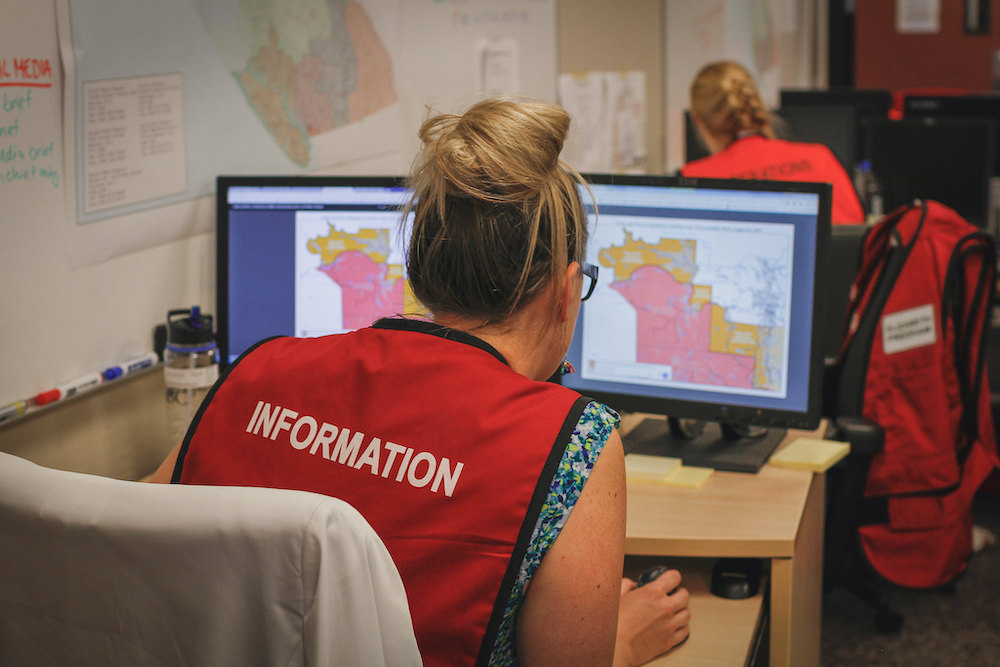
‘Painting the Picasso’: situational awareness for the emergency manager
December 7, 2023
By Jim Montgomery
 Emergency response crew team member pores over wildfire data. Photo by Province of BC.
Emergency response crew team member pores over wildfire data. Photo by Province of BC. Recently a good friend and an experienced emergency management professional, Jeff Warren, posted on LinkedIn a very simple post providing situational awareness of an upcoming environmental situation and the potential impacts.
Possibility of 5-10 cm of snow in Capital Sector tomorrow. Potential impacts to road/driving conditions and power infrastructure.
What is situational awareness? Researchers have defined it as the proactive sense-making of a situation. Examples from a recent research utilisation resource:
- Actively seeking input from a broad range of team members;
- Actively encouraging personnel to question decisions that do not make sense to them; and
- Encouraging personnel to bring up potential problems.
Public Safety Canada’s National Emergency Response System says the following about situational awareness:
Situational awareness is the review of incoming reporting of an incident whereby awareness is developed preparatory to providing information on the event as it is unfolding. These materials are reviewed and incorporated into situation reports for decision making purposes. The situational awareness function builds on incident detection and screening processes. It includes some or all of the following activities:
- Reviewing, analyzing and synthesizing information from various sources, both published and sensitive, and assessing its credibility;
- Liaising with various contacts in federal, provincial and territorial governments (including the security and intelligence community), international partners, and private sector;
- Consulting appropriate federal, provincial and territorial counterparts and private industry contacts;
- Conferring with foreign contacts as appropriate;
- Communicating information to decision makers and government departments; and
- Providing geomatics products to improve situational awareness.
Information should flow freely between governments and stakeholders except when an event or particular information product has national security implications or other constraints which may limit distribution. All provinces and territories regularly share event information with their provincial and federal partners through a variety of communication methods (i.e., email, telephone, fax) and/or situation reports. The manner in which this information is communicated largely depends on the urgent nature and/or complexity of the incident.
Key to obtaining and maintaining situational awareness is identifying essential elements of information (EEI). So what are EEIs?
EEIs are those key pieces of information that decision makers will use to develop and formulate situational awareness for the purpose of developing the common operating picture (COP) or Painting the Picasso. Intra and inter-agency definition of EEIs can be very similar or very different, it greatly depends on that organization’s jurisdictional authorities, responsibilities or mandate. Through the pre-identification of EEIs an organization requires, we can improve the accuracy and efficiency of the development of situational awareness and ultimately the common operating picture.
With each piece of the EEIs, Painting the Picasso allows the COP to assist each organization to understand what we are looking at.
Canadian Disaster Response Organization’s All-Hazard Incident Management Team utilizes an Incident Command System Form – ICS-209S Incident Status Summary (Specific) – that allows for the collection, validation, collation and display of EEIs for a COP related to a municipal situation.
ICS 209S Incident Status Summary (Specific) Form
Purpose: The Incident Status Summary-Specific (ICS 209-S) provides a specific overview or snapshot in time, utilizing EEIs to develop a common operating picture. Find examples here.
It is generally used for the following purposes:
- To provide command staff and other incident management personnel with specific information for planning for the next operational period.
- Used by the situation unit personnel for posting information on status boards or circulating as required.
- Provides information to the information officer for preparing news media releases.
- Summarizes incident information for local and off-site co-ordination/operations centers.
- To brief incident officials
Jim Montgomery is the CEO and president of the Canadian Disaster Response Organization. This article was originally shared on cdro.ca. Republished with permission.
Print this page